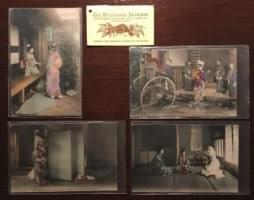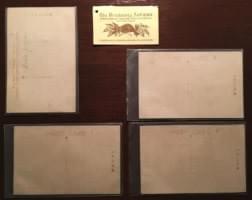I believe that in order to unlock the full power of any collection, you first need to know what it is you actually have to begin with. You need to know what your object is made of, what it looks like and what it measures on record. This might sound obvious, but it is surprising what we can take for granted when collecting objects.
Cataloging a collection is daunting, lets not make light of it, especially if its a large one. But it is not impossible. It can actually be quite manageable, informative and even enjoyable if you approach it the right way. What is the right way? Little by little. Cataloging becomes easier if you layer your process. What does that mean? It means that you start with the information you have right away.
Let me share a project I'm working on with you. I collect postcards. I collect postcards manufactured in a particular way, by specific publishers, in a particular location, at a particular time period, about a pretty specific subject. This collection is a subset of my larger photographs collection. I have been collecting them now for a few years, at first one every couple of months, but now a couple of dozen at a time. It is about time to take stock of what I have.
I made a simple spreadsheet with some basic category columns to begin with. You can make this sheet as complete as you wish, just remember that the more categories you have, the more pressure you might feel to complete. Too many and you might put off cataloging for a long while. Start with a few columns you can fill out with little effort right away. Here's my list of categories from left to right:
accession number, title, object type, media, dimensions, date acquired, inscriptions, description, notes.
Ok, so that right there is nine columns. I'm also using some formal terms commonly used by serious public and private collectors. They can make life a bit easier, especially if you use controlled vocabularies, the way the Getty Research Institute and the Library of Congress do.
The accession number is a number I give to each of the items in my collection. They look like this: 2016.5.14, but no, they have nothing to do with year-month-day dates. The first four digits represent the year I acquired the item, in this case, 2016. The next digit is separated from the year by a period. This digit, in this case the number 5, refers to the order in which it came to the collection, that is to say, this item belongs to the fifth group of postcards in 2016. Finally, the last two digits (number 14), also separated by a period, is the item number in that fifth group. So, 2016.5.14 really means that this item is the 14th postcard in the 5th group of postcards acquired in 2016. This number tells me three things: when I bought the card, in what order and where its place in that group.
For the title I often use the title used in the postcard, for example "Aerial View of XYZ Temple". A descriptive title works well because it can give you both a name and a brief description of the image. The next one's a bit obvious. for object type I'll state 'postcard', and for media 'ink on card stock'. Dimensions are my favourite. I'll measure the height and length with a ruler, i.e. 9.1 cm x 13.8 cm. If you can take more dimensions go for it, you just need the precise instruments to take correct measurements. Next I will record the date I acquired the lot or postcard.
I have a category called inscriptions. Anything written on the card goes in that box. I'll put the exact text that is printed on the front of the card, as well as anything else hand-written or stamped on the back. Not much interpretation here, unless trying to make out some difficult cursive writing or faded out wet-stamps. We then have description, and here I write down a brief description of the object, for instance, "Faded hand-tinted collotype postcard with an image of a Mayan temple in the Guatemalan jungles of Peten. Posted in 1915 from Guatemala City to Houston, Texas." Feel free to add a longer description of those things you feel are most important.
Finally, the notes column is where I put any other critical information that does not have a column. I can put in here some information about who I got it from, or some background information about the subject of the postcard, its sender or recipient. Something like "Sent by John Smith on October 25th 1915 to Helena Gonzales at 3B, 123 Main Street, Houston, Texas. Image on the front is of XYZ Temple before being destroyed in the 1925 earthquake."
A lot of the information you put in the notes field can later be parsed out to other columns once you add them if you wish. The great advantage of typing all this stuff up is that you now have a searchable collection of metadata about the items in your collection. You will know exactly what you have, and you will be able then to sort your collection in a variety of ways that make sense to you.
There are a couple of other things I do to ensure I have the information correct in case I cant start cataloging for a while. Using a very low-tech approach, I simply lay out the cards I bought together, along with the dealer's name and receipt if I have it, and photograph that group front and back (recto and verso) as soon as I get home. This way encoded in the photograph are the date, the time and the geolocation. Three things I don't have to record separately in addition to an exact image of my purchase, which I can then crop to put in my spreadsheet later. Once everything is on the spreadsheet, I can pour over my collection at will, without damaging any of the original objects.

